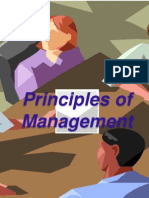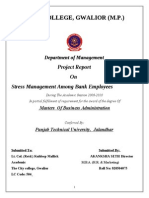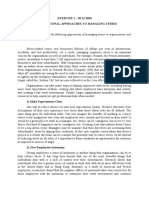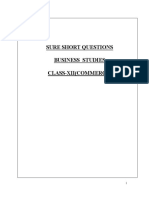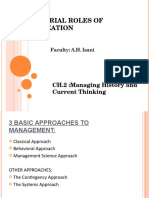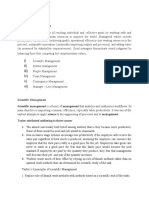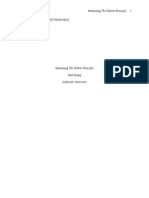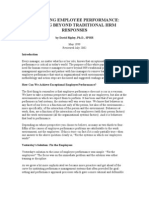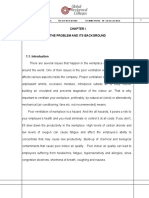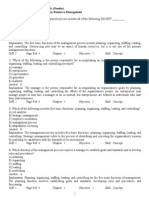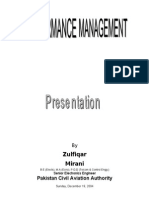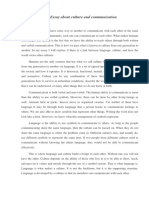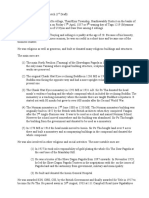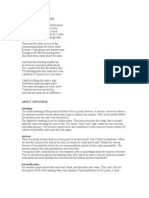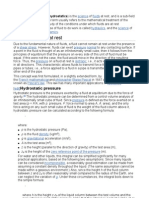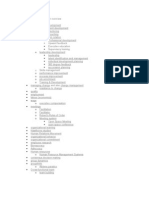0 ratings0% found this document useful (0 votes)
68 viewsAccel Motors
Accel Motors
Uploaded by
Zereen Gail NieveraThe employees at a plant are dissatisfied with their new supervisor and want them removed. This has led to disruptions in production. The plant manager must now address several issues: 1) restoring production levels by gaining control over disgruntled workers, 2) preventing future interruptions, and 3) understanding the motivations and concerns of employees in order to resolve conflicts and boost morale. Various leadership, motivation, and conflict management theories could provide frameworks to analyze the problem and potential solutions.
Copyright:
© All Rights Reserved
Available Formats
Download as DOC, PDF, TXT or read online from Scribd
Accel Motors
Accel Motors
Uploaded by
Zereen Gail Nievera0 ratings0% found this document useful (0 votes)
68 views2 pagesThe employees at a plant are dissatisfied with their new supervisor and want them removed. This has led to disruptions in production. The plant manager must now address several issues: 1) restoring production levels by gaining control over disgruntled workers, 2) preventing future interruptions, and 3) understanding the motivations and concerns of employees in order to resolve conflicts and boost morale. Various leadership, motivation, and conflict management theories could provide frameworks to analyze the problem and potential solutions.
Original Description:
accel motors
Copyright
© © All Rights Reserved
Available Formats
DOC, PDF, TXT or read online from Scribd
Share this document
Did you find this document useful?
Is this content inappropriate?
The employees at a plant are dissatisfied with their new supervisor and want them removed. This has led to disruptions in production. The plant manager must now address several issues: 1) restoring production levels by gaining control over disgruntled workers, 2) preventing future interruptions, and 3) understanding the motivations and concerns of employees in order to resolve conflicts and boost morale. Various leadership, motivation, and conflict management theories could provide frameworks to analyze the problem and potential solutions.
Copyright:
© All Rights Reserved
Available Formats
Download as DOC, PDF, TXT or read online from Scribd
Download as doc, pdf, or txt
0 ratings0% found this document useful (0 votes)
68 views2 pagesAccel Motors
Accel Motors
Uploaded by
Zereen Gail NieveraThe employees at a plant are dissatisfied with their new supervisor and want them removed. This has led to disruptions in production. The plant manager must now address several issues: 1) restoring production levels by gaining control over disgruntled workers, 2) preventing future interruptions, and 3) understanding the motivations and concerns of employees in order to resolve conflicts and boost morale. Various leadership, motivation, and conflict management theories could provide frameworks to analyze the problem and potential solutions.
Copyright:
© All Rights Reserved
Available Formats
Download as DOC, PDF, TXT or read online from Scribd
Download as doc, pdf, or txt
You are on page 1of 2
Facts
1. The employees are not satisfed with their supervisor.
2. They want to oust their supervisor. But why? Not provided.
3. People having difculty to adust with the new supervisor
!. New supervisor is very competitive and competent "ecause although relatively new
in the o"# he was a"le to show some good results such as improving the production
rate.
$. %or&ing environment is not conducive to wor& ' li&e dys(unctional ca(eteria et al.
Statement of the Problem
1. Behavior o( employees
2. )hain o( command * )ontrol Pro"lem * +eadership
3. )ommunications * ,ow do we send the communication across?
!. Production +ost?
,ow do we restore the production line and gain control over disgruntled wor&ers?
Note: Basis for this statement of the problem is the statement in the case.
Statement of Objectives
1. ,ow will the plant manager restore the assem"ly line production?
2. %hat can the plant manager do to prevent (uture interruptions?
3.
Areas of Consideration (Analyses and Assumptions)
!. -otivation theory ' emotional pay"ac& to the employees .what would ma&e them
happy/
$. +eadership theory
0. )ontrol
1. Negotiating and Persuading model
2. )on3ict management
Frameworks
4. Based on Boo&
1. Theory o( Bureaucracy
Principle $5 -anagers must create a well6defned system o( rules# standard
operating procedures# and norms so that they can e7ectively control "ehavior
within the organi8ation. ' -anagement5 )urrent Practices and New 9irections
"y Bruno 9yc& and -itchell Neu"ert# 2:1:
; ,awthourne studies (ound that wor&ers< (eeling and attitudes a7ected their
wor&.... demonstrated that the wor&place was more comple= than previously
thought# that wor&ers were not ust e=tensions o( machines>
> managers understood the e7ect that the group social interactions#
employee satis(action# and attitudes had on individual and group
per(ormance.?' -anagement "y )huc& %illiams# 2:12
2. Theory @ ' involved wor&ers are the &ey on an increase in productivity.
3. )haordic Theory 6
1:. A=pectancy Theory ' relates to motivation.
11. ,er8"ert Theory ' hygiene ' non monitory# motivation ' money# compensation ?
12. Negotiating and Persuading model
13. )on3ict management
Alternative Courses of Action
1!. )all (or Btrong and Cane and as& them the reasons why they did such actions. This
would allow %in(are to identi(y the specifc concerns he needs to address. Ds it
operation pro"lem# satis(action .,E/# "ehavior etc.
1$. Plant manager should "e calm# as& them to come out o( the area and tal& outside o(
the plant.
10. The F30:#::: is already a lost anyway# "y this way this is pegged at this rate. Eather
than challenging them and it would create more damage more than.
You might also like
- Principles of Management.. by Philip KotlerDocument51 pagesPrinciples of Management.. by Philip KotlerSiddhartha Neog86% (7)
- Cell Manual July 2012Document72 pagesCell Manual July 2012Jacobina The-Dynamitess Mwale100% (5)
- PTE Writing EssayDocument7 pagesPTE Writing EssayAceNo ratings yet
- Betting On Yourself by DR Robert AnthonyDocument181 pagesBetting On Yourself by DR Robert Anthonyflyers83100% (5)
- Contribution of F.W. TaylorDocument15 pagesContribution of F.W. TaylorflaksherNo ratings yet
- Management TheoriesDocument7 pagesManagement TheoriesMohamedMoideenNagoorMeeran100% (1)
- 12 Business Studies Principles of Management Impq 1Document3 pages12 Business Studies Principles of Management Impq 1Apoorv AroraNo ratings yet
- NCERT Solutions For Class 12 Business Studies Principles and Functions of Management Chapter 2Document14 pagesNCERT Solutions For Class 12 Business Studies Principles and Functions of Management Chapter 2anonfreakinmousNo ratings yet
- Evoluation of Stress:: Importance Significance of The StudyDocument6 pagesEvoluation of Stress:: Importance Significance of The StudyCG Markeitng MRNo ratings yet
- Management Chapter 1Document13 pagesManagement Chapter 1ChristianLloydSuayanNo ratings yet
- Advanced HR - WSH - Complete - MDocument11 pagesAdvanced HR - WSH - Complete - MrueyNo ratings yet
- Advanced HR - WSH - CompleteDocument11 pagesAdvanced HR - WSH - CompleterueyNo ratings yet
- Chapter 7 Design of Work SystemDocument26 pagesChapter 7 Design of Work Systemhamidpunjabian10No ratings yet
- WKo Hyq 87 U Ps IWH975 C WODocument17 pagesWKo Hyq 87 U Ps IWH975 C WOakhilsharmac1140No ratings yet
- Stress ManagementDocument50 pagesStress ManagementRavi JoshiNo ratings yet
- Exercise 2 - Organizational Approaches To Managing Stress - 03.12.2020Document4 pagesExercise 2 - Organizational Approaches To Managing Stress - 03.12.2020Alin ApostolescuNo ratings yet
- Lecture15 26may FT WorkstudyDocument6 pagesLecture15 26may FT Workstudysatyam udainiyaNo ratings yet
- (OCM) Chapter 1 Principles of ManagementDocument23 pages(OCM) Chapter 1 Principles of ManagementMehfooz PathanNo ratings yet
- Sure Short Questions Business Studies Class-Xii (Commerce)Document35 pagesSure Short Questions Business Studies Class-Xii (Commerce)JaspreetNo ratings yet
- Industrial and Managerial Economics Assignment-1Document18 pagesIndustrial and Managerial Economics Assignment-1Kunal RawatNo ratings yet
- Worksheets 1-5 (Withpout Answer Key)Document9 pagesWorksheets 1-5 (Withpout Answer Key)Vidhan GuptaNo ratings yet
- Thnigs To Remember For PMPDocument7 pagesThnigs To Remember For PMPchitty_r_2003No ratings yet
- Macs Mod 1 - 8 NotesDocument42 pagesMacs Mod 1 - 8 NotesSahil GouthamNo ratings yet
- Mistakes in AuditDocument4 pagesMistakes in AuditRajaSekarsajjaNo ratings yet
- Sem 1 Principles of Management Module 1 Management Theories Section IIDocument9 pagesSem 1 Principles of Management Module 1 Management Theories Section IILakshita BaggaNo ratings yet
- 1Document8 pages1api-352131221No ratings yet
- Hunayun SM (Autosaved)Document5 pagesHunayun SM (Autosaved)Sõúmëñ AdhikaryNo ratings yet
- Mro CH.2Document26 pagesMro CH.2Pata NheNo ratings yet
- A Project Report On Stress Management Among Bank EmployeesDocument68 pagesA Project Report On Stress Management Among Bank EmployeesLovely SainiNo ratings yet
- Factors Affecting Organisational StructureDocument13 pagesFactors Affecting Organisational StructureMit Mecwan100% (1)
- Problem Solving Using Systems ApproachDocument11 pagesProblem Solving Using Systems ApproachKunal RathodNo ratings yet
- Assignment On Pol - SCDocument8 pagesAssignment On Pol - SCbullokanioNo ratings yet
- Prosperity: For The: 1) Scientific Study and Planning of WorkDocument4 pagesProsperity: For The: 1) Scientific Study and Planning of Worksanjay975No ratings yet
- BS Principles of Management CHAPTERDocument19 pagesBS Principles of Management CHAPTERPrateek TodurNo ratings yet
- Employee AttrDocument59 pagesEmployee AttrAndrewVazNo ratings yet
- Practical Steps To Achieve One Goal After Another. It Starts With Taking A Simple Step ofDocument12 pagesPractical Steps To Achieve One Goal After Another. It Starts With Taking A Simple Step ofimtiaztabassamNo ratings yet
- MIS - Unit 4 Management ModelsDocument10 pagesMIS - Unit 4 Management ModelsRichard PholoshieNo ratings yet
- The Dilbert PrincipleDocument10 pagesThe Dilbert PrincipleSmart SivaNo ratings yet
- Unit-1 - Part 1Document33 pagesUnit-1 - Part 112312312341235No ratings yet
- Pom CH 2Document17 pagesPom CH 2Junaid ZafarNo ratings yet
- Ob Final ProductivityDocument15 pagesOb Final ProductivitySharjil ZaiDiNo ratings yet
- Employee RelationsDocument76 pagesEmployee RelationsbikshapatiNo ratings yet
- Short Answer QuestionsDocument5 pagesShort Answer Questionsdurgasankar.shambuNo ratings yet
- Tata LeadershipDocument41 pagesTata LeadershipAsifshaikh7566No ratings yet
- Improving Employee Performance: Moving Beyond Traditional HRM ResponsesDocument6 pagesImproving Employee Performance: Moving Beyond Traditional HRM ResponsesAriful IslamNo ratings yet
- The Problem and Its Background: Od-Fearing Eciprocating Ommitting To ExcellenceDocument22 pagesThe Problem and Its Background: Od-Fearing Eciprocating Ommitting To ExcellenceRonnie Serrano PuedaNo ratings yet
- THEORY & PRACTICE OF PUB AD COURSE WORK I Dela Cuesta-1Document4 pagesTHEORY & PRACTICE OF PUB AD COURSE WORK I Dela Cuesta-1glaezeldelacuestaNo ratings yet
- Lessons Learned From The Red Bead ExperimentDocument8 pagesLessons Learned From The Red Bead Experimentanjo0225No ratings yet
- Proposal On Effects of Poor Office Environment On The Motivaton of Workers in An OrganizationDocument13 pagesProposal On Effects of Poor Office Environment On The Motivaton of Workers in An OrganizationObinna Steve NwaforNo ratings yet
- Dessler Hrm12 Tif01Document27 pagesDessler Hrm12 Tif01Syed Muhammad Haris HayatNo ratings yet
- Desiree Smith - Case Analysis - The New Plant ManagerDocument6 pagesDesiree Smith - Case Analysis - The New Plant ManagerDes SmithNo ratings yet
- Unit 1 - Overview of Management ScienceDocument51 pagesUnit 1 - Overview of Management ScienceKathleen Laica P. SablayNo ratings yet
- 24467136whatispms 12654839345788 Phpapp01Document17 pages24467136whatispms 12654839345788 Phpapp01Avinandan KumarNo ratings yet
- Viva QuestionsDocument41 pagesViva Questionslin_guardianangelNo ratings yet
- Homework Assignment For 4D1165 Behavioural Management Control Year 2007Document17 pagesHomework Assignment For 4D1165 Behavioural Management Control Year 2007Siju BoseNo ratings yet
- Job Satisfaction Among Employees in Nationaliized Bank APDocument74 pagesJob Satisfaction Among Employees in Nationaliized Bank APsadiboy100% (1)
- Capi Fundamentals of Management July2015Document4 pagesCapi Fundamentals of Management July2015सुजन सापकोटाNo ratings yet
- Herzberg's Motivation Theory - Two Factor TheoryDocument19 pagesHerzberg's Motivation Theory - Two Factor TheoryHan MyoNo ratings yet
- +2 Business Chapter 2 NotesDocument24 pages+2 Business Chapter 2 NotesUnicorn ChannelNo ratings yet
- Motivation and Job Analysis SynopsisDocument17 pagesMotivation and Job Analysis SynopsisCrystal AdamsNo ratings yet
- Industrial PhycologyDocument21 pagesIndustrial PhycologyThilini DulanjaliNo ratings yet
- Tec SmartDocument7 pagesTec SmartZereen Gail Nievera100% (1)
- Case 3-1 PDFDocument3 pagesCase 3-1 PDFZereen Gail Nievera100% (2)
- Shelter PartnershipDocument3 pagesShelter PartnershipZereen Gail Nievera0% (1)
- Reflection Enron CaseDocument2 pagesReflection Enron CaseZereen Gail NieveraNo ratings yet
- Innovation Is Change: 1. Recognize Change 2. Unfreeze 3. Change 4. Refreeze Management Book by Bruno DyckDocument2 pagesInnovation Is Change: 1. Recognize Change 2. Unfreeze 3. Change 4. Refreeze Management Book by Bruno DyckZereen Gail NieveraNo ratings yet
- Essay About Culture and CommunicationDocument3 pagesEssay About Culture and CommunicationSlavikMunteanuNo ratings yet
- Excel List of BooksDocument17 pagesExcel List of BooksRavipr PaulNo ratings yet
- Common School SystemDocument3 pagesCommon School SystemJyotirmoy SamaddarNo ratings yet
- English For Social and Political ScienceDocument71 pagesEnglish For Social and Political ScienceAnna DzimanNo ratings yet
- Report On School Activity - 2018Document1 pageReport On School Activity - 2018sirthana697547No ratings yet
- Activity 3.2.1 Product ObservationDocument4 pagesActivity 3.2.1 Product ObservationNick WolcottNo ratings yet
- Noun, Pronoun VerbDocument24 pagesNoun, Pronoun VerbHammad Ali ShahzadNo ratings yet
- KJV The American Patriot's Bible - The Book of JamesDocument10 pagesKJV The American Patriot's Bible - The Book of JamesThomas Nelson BiblesNo ratings yet
- Final OutputDocument15 pagesFinal Outputmelody longakitNo ratings yet
- Sir Po Tha2Document2 pagesSir Po Tha2U Soe Paing UCCNo ratings yet
- The Roads Not TakenDocument3 pagesThe Roads Not TakenJHe Nii' MourenthyNo ratings yet
- 2018 STAAR Gr4 Writing Scoring Guide 09-14-18Document24 pages2018 STAAR Gr4 Writing Scoring Guide 09-14-18betusenormousNo ratings yet
- Mckenna Wagenman Tree OctopusDocument3 pagesMckenna Wagenman Tree Octopusapi-311832488No ratings yet
- Methods of Problem Solving in KinematicsDocument6 pagesMethods of Problem Solving in KinematicsVikram AdityaNo ratings yet
- "The Book of Job: A Biography" by Mark Larrimore.Document24 pages"The Book of Job: A Biography" by Mark Larrimore.OnPointRadioNo ratings yet
- Dative CaseDocument18 pagesDative Caseromance.man333No ratings yet
- Written Marketing Plan Marking RubricDocument3 pagesWritten Marketing Plan Marking RubricTaylorNo ratings yet
- Pressure in Fluids at RestDocument4 pagesPressure in Fluids at Restkashif55663844No ratings yet
- NietzscheimpactDocument11 pagesNietzscheimpactAri EstisNo ratings yet
- The Reality About The Prophet's Parents: Shaykh Muhammad Ibn Alawi MalikiDocument10 pagesThe Reality About The Prophet's Parents: Shaykh Muhammad Ibn Alawi MalikiAhmad DandarawieNo ratings yet
- Terrible Fish in Sylvia Plath's Mirrors: Perception and Relevance of Mirror ImageryDocument19 pagesTerrible Fish in Sylvia Plath's Mirrors: Perception and Relevance of Mirror ImagerysanamachasNo ratings yet
- Simpsons Scientific Method-KeyDocument2 pagesSimpsons Scientific Method-KeyJoy Perez50% (2)
- Footprints in The Sand Poem Ryan HartDocument1 pageFootprints in The Sand Poem Ryan HartGilmalyn De VeraNo ratings yet
- Fairyland 3Document6 pagesFairyland 3Cuibuș Mihaela LauraNo ratings yet
- MBA HR Project TopicsDocument5 pagesMBA HR Project Topicsdeepalidwivedi0% (1)
- The True Essence of LifeDocument3 pagesThe True Essence of LifeRuth FloresNo ratings yet
- Lesson Plan Period 6Document3 pagesLesson Plan Period 6api-241257283No ratings yet
